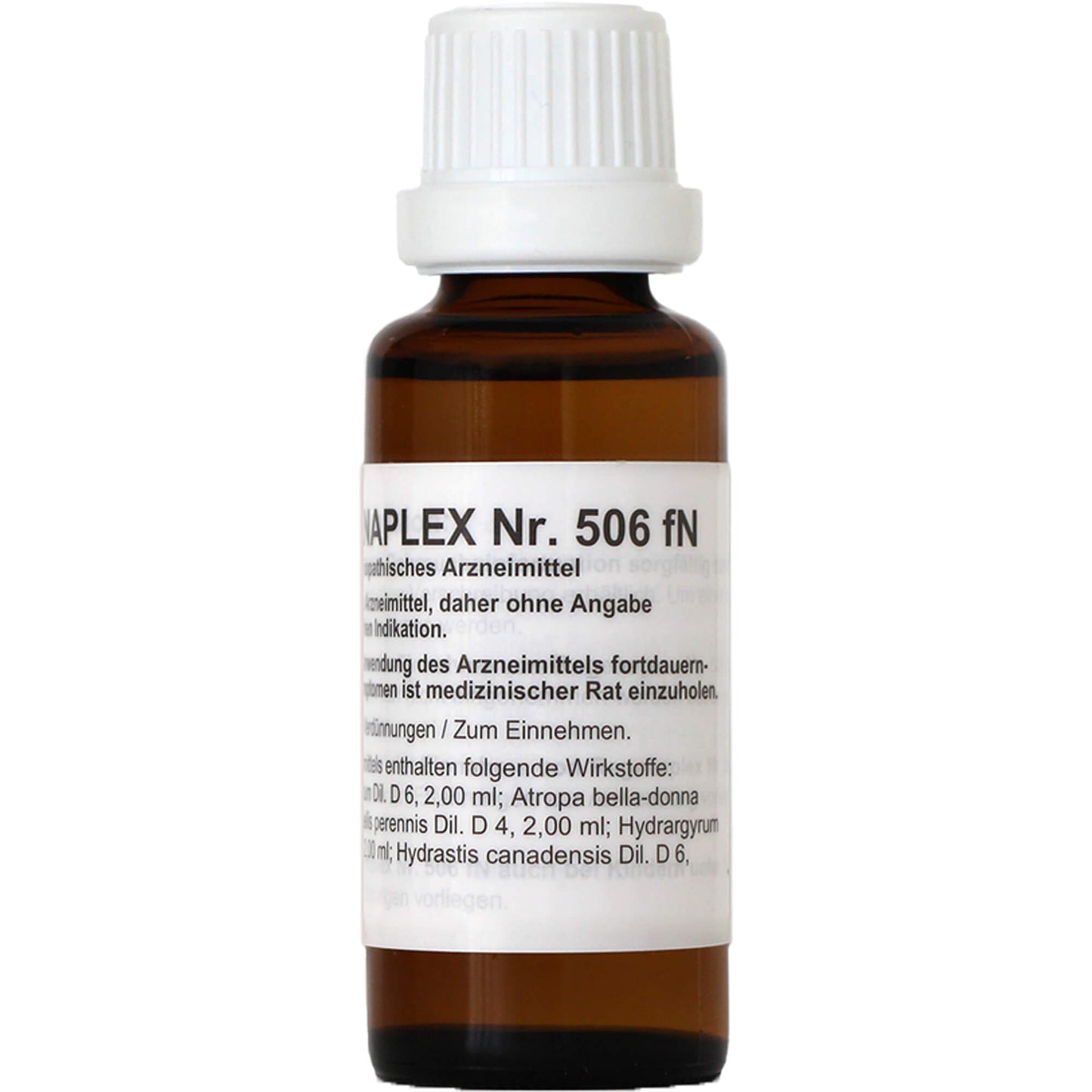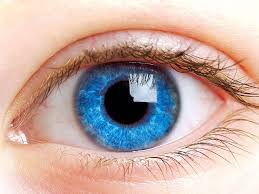REGENAPLEX GmbH
Atropa belladonna, Bellis perennis, Hydrastis canadensis, REGENAPLEX No. 506 fN
Atropa belladonna, Bellis perennis, Hydrastis canadensis, REGENAPLEX No. 506 fN
Couldn't load pickup availability
Atropa belladonna, Bellis perennis, Hydrastis canadensis, REGENAPLEX No. 506 fN Oral Drops
- Pack size:
- 30 ml
- Dosage form:
- Drops for oral use
REGENAPLEX No. 506 fN Drops. Indications: Registered homeopathic medicinal product, therefore no therapeutic indication is specified. Warning: Contains 50% alcohol by volume!
Homeopathic medicine
Active ingredients
- 0.2 ml Atropa belladonna D6
- 0.2 ml Bellis perennis D4
- 0.2 ml Hydrastis canadensis D6
- 0.2 ml Ammonium bromatum D6
- 0.2 ml Hydrargyrum chloratum D9
Excipients
- Ethanol
Composition
10 ml contains 2.00 ml each:
Ammonium bromatum D6, Atropa bella-donna D6, Bellis perennis D4, Hydrargyrum chloratum D9, Hydrastis canadensis D6.
What should you consider before taking Regenaplex Regenaplex No. 506fN?
Regenaplex No. 506fN should not be taken if you are known to be hypersensitive to Bellis perennis (daisy) or other members of the Asteraceae family.
Special care is required when taking Regenaplex No. 506fN during pregnancy and breastfeeding. Since there is no sufficiently documented experience with its use, the medicine should only be used after consulting a doctor. Also, only use Regenaplex No. 506fN on children under 12 years of age after consulting a doctor, as there is no sufficiently documented experience. Interactions with other medicines are not known.
General note: The effect of a homeopathic medicine can be adversely affected by generally harmful lifestyle factors and by stimulants and stimulants. If you are taking other medicines, consult your doctor.
How should Regenaplex No. 506fN be used?
Unless otherwise prescribed, for acute conditions, take 5 drops every half to one hour, up to a maximum of 6 times daily. For chronic conditions, take 5 drops 1-3 times daily. Continued use for longer than 1 week should only be undertaken after consultation with a homeopathic practitioner. If symptoms improve, reduce the frequency of use. If your symptoms worsen or if there is no improvement after a few days, you must consult a doctor. Homeopathic medicines should also not be taken for long periods without medical advice.
What are the possible side effects?
Due to the ingredient Hydrargyrum (mercury), increased salivation may occur after use. The remedy should then be discontinued.
Note: When using homeopathic medicines, existing symptoms may temporarily worsen (initial worsening). In this case, you should discontinue use and consult your doctor. If you experience any side effects, please report them to your doctor or pharmacist.
Other warnings:
Contains 49% alcohol by volume
Atropa belladonna benefits:
belladonna is taken by mouth as a sedative, to stop bronchial spasms in asthma and whooping cough, and as a cold and hay fever remedy. It is also used for Parkinson's disease, colic, inflammatory bowel disease, motion sickness, and as a painkiller.
Bellis perennis benefits:
Bellis perennis, commonly known as the daisy, has a history of use in traditional medicine and is gaining attention for its potential skin and wound healing benefits. It may help protect skin from environmental damage, promote even skin tone, and improve firmness. Additionally, daisy extracts are being investigated for their potential antimicrobial and anti-tumour properties.
Potential Benefits:
Skin Protection: Bellis perennis extract may help protect the skin from environmental damage.
Skin Tone: It is thought to promote a more even skin tone.
Firmness: May improve skin firmness.
Wound Healing: Daisy has been used traditionally to treat bruises, broken bones, and other injuries. It possesses astringent and demulcent properties, which can aid in wound healing.
Anti-inflammatory: Daisy extracts are believed to have anti-inflammatory properties, potentially helpful for conditions like bronchitis and other upper respiratory tract inflammations.
Antimicrobial: Research is exploring its potential antimicrobial properties.
Anti-tumour: Studies are investigating the potential anti-tumour activity of Bellis perennis.
Musculoskeletal Issues: Bellis perennis may help relieve musculoskeletal issues like back pain, joint pain, or stiffness.
Hydrastis canadensis benefits:
Goldenseal is an herbal remedy that some people use to treat colds, hay fever, digestive problems, and other health conditions.
Ammonium bromatum benefits:
Ammonium Bromatum is a homeopathic remedy for chronic obesity and those who suffer from chronic laryngeal and pharyngeal catarrh and neuralgic headaches.
It is primarily used for the treatment of ciliary neuralgia and its associated ailments.
Hydrargyrum chloratum benefits:
Hydrargyrum chloratum, also known as mercurous chloride or calomel, has been used in traditional medicine for various purposes, including wound healing and as a topical treatment for skin conditions. It is a component of some traditional Chinese medicine formulations, such as Hydrargyrum chloratum compositum (Hcc), which is used for "transforming corrosion and pulling out toxins" and promoting tissue repair. However, it's important to note that mercuric chloride (HgCl2), a key component of Hcc, is potentially toxic and can cause kidney damage with long-term use.
Here's a more detailed look at the purported benefits and risks:
Potential Benefits:
Wound Healing:
Hcc has been shown to promote wound healing in traditional medicine, potentially through antibacterial activity, modulation of immune responses, and promotion of angiogenesis (new blood vessel formation).
Antimicrobial Activity:
Mercurous chloride has demonstrated broad-spectrum antibacterial activity, which can help in preventing or treating infections in wounds.
Tissue Repair:
Traditional uses include "removing corrosion and regenerating muscles," suggesting a role in tissue repair and regeneration.
Treatment of Skin Conditions:
It has been used for conditions like tinea cruris (jock itch) and other skin ulcers and infections.
Dredging Meridians and Promoting Blood Circulation:
In traditional Chinese medicine, it's also believed to have effects on meridians and blood circulation, potentially aiding in pain relief and reducing swelling.
Potential Risks:
Toxicity:
Mercuric chloride (HgCl2), a key component of Hcc, is toxic and can cause kidney damage, especially with prolonged use.
Not a Substitute for Conventional Treatment:
While it may be used in traditional medicine, it's crucial to consult with a healthcare professional and not rely solely on Hcc for serious conditions, particularly those requiring conventional medical treatment.
Limited Evidence:
While traditional use is extensive, scientific evidence supporting the efficacy and safety of Hcc for all its claimed uses is still limited.
Need for Further Research:
More research is needed to fully understand the mechanisms of action and potential risks associated with Hcc, especially in the context of its topical application.
Important Considerations:
Medical Supervision:
Any use of Hcc or related preparations should be done under the guidance of a qualified healthcare professional or traditional medicine practitioner.
Dosage and Preparation:
Dosage and preparation methods vary, and it's crucial to follow recommended guidelines to minimize potential risks.
Not a Replacement for Conventional Treatment:
Hcc should not be considered a replacement for conventional medical treatments, especially for serious or chronic conditions.
Atropa belladonna, Bellis perennis, Hydrastis canadensis, REGENAPLEX No. 506 fN
Share



